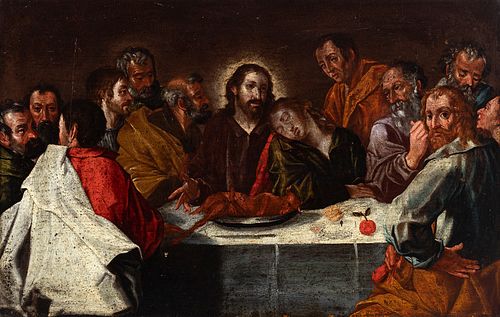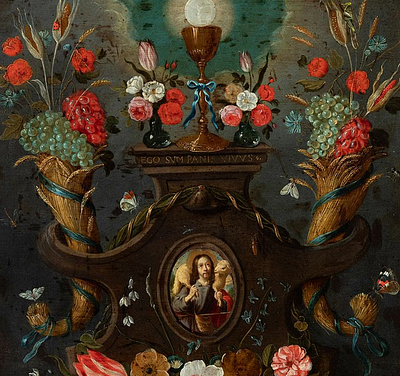Cordovan school; 17th century. "Last Supper". Oil on pine panel.
Lot 24
About Seller
Setdart Auction House
Carrer Aragó 346
Barcelona
Spain
Setdart Subastas was born in 2004 and is currently the first online art auction in Spain with solidity, prestige and reliability guaranteed by our more than 60,000 users. Setdart has a young, dynamic and enterprising team ready to successfully manage the purchase and sale of art works through custom...Read more
Estimate:
EUR€3,000 - EUR€4,000
$3,157.89 - $4,210.53
Absentee vs Live bid
Two ways to bid:
- Leave a max absentee bid and the platform will bid on your behalf up to your maximum bid during the live auction.
- Bid live during the auction and your bids will be submitted real-time to the auctioneer.
Bid Increments
| Price | Bid Increment |
|---|---|
| EUR€0 | EUR€10 |
| EUR€200 | EUR€25 |
| EUR€500 | EUR€50 |
| EUR€1,000 | EUR€100 |
| EUR€3,000 | EUR€200 |
| EUR€5,000 | EUR€500 |
| EUR€10,000 | EUR€1,000 |
| EUR€20,000 | EUR€2,000 |
| EUR€50,000 | EUR€5,000 |
About Auction
By Setdart Auction House
Sep 21, 2021
Set Reminder
2021-09-21 10:00:00
2021-09-21 10:00:00
America/New_York
Bidsquare
Bidsquare : 21st September - ARAS JÁUREGUI Private Collection - Old Masters, 19th & 20th Century
https://www.bidsquare.com/auctions/setdart-auction-house/21st-september---aras-j-uregui-private-collection---old-masters-19th-20th-century-7429
Setdart Auction House sofia@setdart.com
Setdart Auction House sofia@setdart.com
- Lot Description
Cordovan school; 17th century. "Last Supper". Oil on pine panel. It has an Andalusian frame of the period. It presents damages caused by xylophagous. Measurements: 26,5 x 41 cm; 35,5 x 50 cm (frame). The work shows a room of simple architecture illuminated only thanks to the halo of sanctity emanating from the head of Christ. In the foreground is the table, with the apostles arranged next to it, except for the central area, which is cleared to allow the figure of Jesus to be placed in the centre of the table. The work shows the moment when Jesus alludes to the bread that he will dip to identify the betrayer, which took place at the Last Supper. This is a key moment in the Gospel for Christianity. Its representation has been really frequent throughout the History of Art, the best known, perhaps, is the fresco by Leonardo da Vinci, with the larger side of the table towards the viewer, following what is surely the most normal position for the piece of furniture, as it allows an easy composition; However, there are also numerous works with another type of table, and many with an Apostle with his back to the viewer (normally one is Judas, to take advantage of the situation and place the bag of silver coins on his back, held with one hand, as Rubens and Maarten van Heemskerck do, for example, in the drawing in the Museo del Prado - which shows a very similar pose to the Judas in this work - or Flemish tables such as St Peter in Louvain by Dieric Bouts...). ). In terms of aesthetics and subject matter, the work has similarities with the painting of the artist Pablo de Céspedes (c. 1538/1548-Córdoba, 1608), of noble origin. Pablo was born and raised in the house of his father's maternal uncle, Francisco López de Aponte, a canon of Córdoba, where he received a scholarly education. At the age of eighteen, in 1556, he was sent to the Complutense University of Alcalá de Henares, where he devoted himself to the acquisition of oriental languages and theology. He later moved to Rome where he studied painting with Federico Zuccari. He was in Rome in 1559, engaged in conducting certain negotiations for Archbishop Carranza de Miranda of Toledo, who was later accused of heresy before the Valladolid Inquisition. He remained in Italy for more than 20 years and gained a great reputation as an artist. He returned to Spain in 1577 and was appointed canon of Cordoba cathedral. He continued to write books on antique subjects, such as the architecture of Solomon's temple.
- Shipping Info
-
In-house shipping available. Please inquire at admin@setdart.com.
-
- Buyer's Premium



 EUR
EUR CAD
CAD AUD
AUD GBP
GBP MXN
MXN HKD
HKD CNY
CNY MYR
MYR SEK
SEK SGD
SGD CHF
CHF THB
THB
















